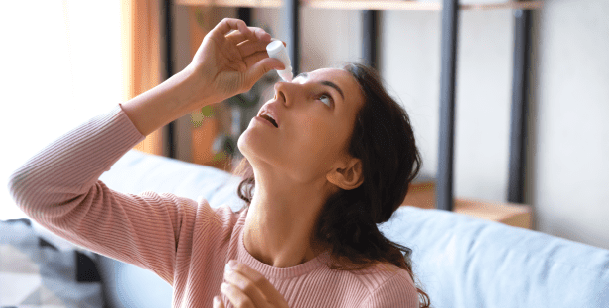Suffering from eye infections is no fun! Village Emergency Centers has put together a brief summary of several common eye infections, their symptoms, and the various treatment options available to help patients navigate these uncomfortable conditions. Continue reading to learn more!
Conjunctivitis
Infectious conjunctivitis, more commonly known as “pink eye”, occurs when the blood vessels in the outermost membrane of the eyeball become infected by a virus or bacteria.
Conjunctivitis symptoms include:
- A reddish or pinkish tint to the eyes
- Watery discharge from the eyes that is thickest upon waking
- Itchiness or feelings of a foreign object in the eye
- Inordnant eye watering, especially in only one eye
The type of treatment used for patient conjunctivitis will depend on the nature of the infection. A bacterial or fungal infection will be treated by topical or oral antibiotics, or by antibiotic eye drops. Conjunctivitis caused by allergies can usually be treated with antihistamines.
There are no available viral conjunctivitis treatment options; however, symptoms will usually resolve on their own in seven to ten days. To help ease discomfort, apply a clean, warm, wet cloth to the affected area.
It is important to note that conjunctivitis is extremely contagious. To avoid spreading the infection, avoid touching your eyes, wash your hands frequently and avoid contact with others.
Ocular Herpes
Ocular herpes, also called “eye herpes” occurs when the herpes simplex virus infects the eye. This virus, HSV-1, is not an STI and is not spread through sexual contact. Ocular herpes usually affects only one eye at a time.
Symptoms of an ocular herpes infection may include:
- Pain, inflammation, and irritation of the eye and/or eyelid
- Sensitivity to light
- Blurry vision
- Excess tear production
- Thick and watery discharge from the eye.
Symptoms of ocular herpes infection may resolve on their own but can be treated with antiviral medication.

Uveitis
Uveitis is an inflammation of the uvea that results from viral infections, eye injury, or immune system conditions. The uvea is the part of the eye of the eyeball that transports blood to the retina. This means that, while uveitis does not usually cause long term issues, vision can be affected if this condition is left untreated.
Symptoms of uveitis can include:
- Eye pain
- Redness
- “Floaters” in the field of vision
- Sensitivity to light
- Blurred vision
For treatment of this condition, physicians usually recommend the following:
- Wearing dark glasses
- Dilating eye drops
- Oral steroids that relieve inflammation
For more severe cases of uveitis, more involved treatments may be needed. Additionally, if uveitis is caused by an underlying condition, recovery could take up to several months.
Endophthalmitis
Endophthalmitis is a severe inflammation of the inside of your eye, usually caused by a bacterial or fungal (candida) infection. This condition may arise after cataract surgery or other eye surgeries, or if your eye is penetrated by a foreign object.
Symptoms may include:
- Eye pain
- Blurred, partial, or complete loss of vision
- Redness or swelling
- Pus or discharge
- Sensitivity to light
To treat endophthalmitis, antibiotics are injected directly into the eye. A corticosteroid shot may also be administered to relieve inflammation.
If there is a foreign object in the eye that is causing the infection, it must be removed immediately. Do not attempt to remove the foreign body yourself. Instead, seek immediate medical attention from trained professionals.
After the administration of the proper antibiotics and after the object is removed, symptoms can begin to resolve in two to three days.
Sty
A sty, also known as a hordeolum, is a pimple-like bump that develops on the outer edges of the eyelids, usually as a result of clogged oil glands along the lash line. Oil glands can be clogged with dead skin, natural oils, and other matter, allowing bacteria to overgrow and create a sty.
Sty symptoms include:
- Eye pain or tenderness
- Itchiness or irritation
- Swelling
- Increased tear production
- Crustiness around the eyelids
An antibiotic ointment can be applied to help kill the bacterial overgrowth. In the meantime, patients can relieve discomfort and avoid further irritation by doing the following:
- Applying a clean, warm, damp cloth for 20 minutes at a time.
- Using mild, scent-free soap and water to clean eyelids
- Using over-the-counter pain relievers
- For people who wear contact lenses, avoiding contact lens use
- Avoiding the use of eye makeup

How to Prevent Common Eye Infections
There are several easy ways to avoid contracting common eye infections. Here are a few daily habits you can practice to help your eyes stay healthy:
- Avoid touching your eyes without having washed your hands.
- Wash hands frequently and shower regularly.
- Eat an anti-inflammatory diet.
- Only use clean towels and tissues on your eyes.
- Avoid sharing eye and face makeup.
- Wash bedsheets and pillowcases weekly.
- Use contact lenses as instructed.
- Use contact solution to disinfect lenses daily.
- Avoid contact with those who have conjunctivitis.
- Replace objects that’ve been in contact with an infected eye.
Get Help From Village Emergency Centers
If you or a loved one is suffering from one of these common eye infections, do not hesitate to reach out to medical professionals for help! Getting the proper treatment is essential to relieving discomfort and avoiding any long term damage to your eyes. Find your Village and learn more about our services today by visiting our website.
